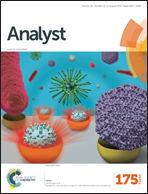Monolith dip-it: a bifunctional device for improving the sensitivity of direct analysis in real time mass spectrometry†
Abstract
A bifunctional monolith dip-it was fabricated and applied for improving the sensitivity of direct analysis in real time mass spectrometry (DART-MS). This monolith dip-it device was prepared by in situ polymerization of poly(BMA–EDMA–MAA) monolith in the glass capillary of dip-it. As a solid-phase microextraction (SPME) device, it showed strong affinity to four Sudan dyes through hydrophilic interaction and hydrogen bond interaction. As a sample loading device, it could be directly analyzed by DART-MS without organic solvent elution or laser desorption. As a result, this device is environmentally friendly, and used for fast analysis. Under optimized conditions, the limits of detection for four analytes were 5–10 ng mL−1 and the linear ranges covered more than two orders of magnitude. Finally, the developed method has been applied for the analysis of chili powder and the recoveries for spiked analytes were in the range of 83.2% to 115.1% demonstrating that this device is an efficient sampler for DART-MS analysis and the proposed method could find more applications in different areas like food analysis.


 Please wait while we load your content...
Please wait while we load your content...